Canada's Food Guide -
Focus on Children 6-12 years -
Background for Educators and Communicators
Help on accessing alternative formats, such as PDF, MP3 and WAV files, can be obtained in the alternate format help section.
 (1.94 MB) (1.94 MB)
** Please note: the PDF version of this document
is large and may take a few minutes to download.
Published by the authority of the Minister of Health
We'd like to thank the children and parents who participated in the Food
for Thought survey and whose quotes are scattered throughout this
booklet.
This publication is available on computer diskettes or in large print,
upon request.
Également disponible en français sous le
titre Le Guide alimentaire canadien pour manger sainement : Renseignements
sur les enfants de six à douze ans
© Minister of Public Works and Government Services Canada, 1997
Cat: H39-308/1-1997E
ISBN: 0-662-25732-4
No changes permitted. Reprint permission not required.
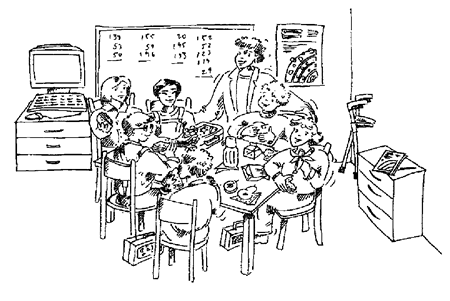
Ideas and information on Canada's Food Guide to Healthy Eating
for people who work with children six to twelve years of age
Our mission is to help the people of canada maintain
and improve their health. -Health Canada
In Brief
Why read this?
What influences children's eating?
Setting healthy patterns for life
What is healthy eating for children?
Making healthy eating easier
More materials on children
and healthy eating
Why Read This?
Personal health practices, such as healthy eating, play a large part
in determining how healthy people will be.
Between the ages of six and twelve, children are learning to make decisions
and beginning to make more choices on their own. They are developing attitudes
and habits that they will carry with them for the rest of their lives.
The adults who were previously making decisions for them need to continue
to provide guidance and support while allowing children to think for themselves.
Read this booklet to:
- understand the things that influence children's attitudes and behaviours
around eating;
- help children learn about healthy living and develop the decision-making
skills they need to make healthy food choices; and
- create situations that make healthy food choices easier.
Canada's Food Guide to Healthy Eating is a central resource to
this booklet. Becoming familiar with the Food Guide and having copies
for the children you work with can help them learn to make healthy choices.
See the section More Materials on Children and Healthy Eating to find out how to get copies of the Food Guide and other
useful resources.
You are in a position to influence the choices children make today and
in the future. When promoting healthy eating, you can use this information
to strengthen your influence!

What Influences Children's Eating?
Many factors influence what children eat. As children grow and become
more independent, they make more of their own food choices. But they still
look up to their parents and other adults around them for direction. When
they don't get this direction, they are more open to the influence of
the media and their peers.
"It's good for your health" is not a statement that will have much impact
on children's food choices. Other factors are much more powerful because
children make choices to address their immediate needs and wants. These
factors include:
- Taste: The main reason children give for
choosing a favourite food is almost always taste. Children choose foods
because they taste good and because eating those foods makes them feel
good.

- Family influences: Children say that parents
are their most important source of information and influence for healthy
eating. Family eating habits, activity patterns and attitudes toward
food and eating have an enormous influence on children. For example,
if the family eats breakfast, it's likely the children will, too. Family
income is another factor that influences what children eat and the food
choices that are available to them.
- School policies and practices: Both children
and their parents say that school has an important influence on what
children eat. School nutrition education programs are a key source of
information about healthy eating. As well, school food policies can
reinforce in-class education.immediate needs and wants. These available
to them. For example, children taught in class about nutritious snacks
need to see them featured during school events or in the cafeteria.
Similarly, school lunch time needs to be sufficiently long to support
eating in the presence of many distractions.
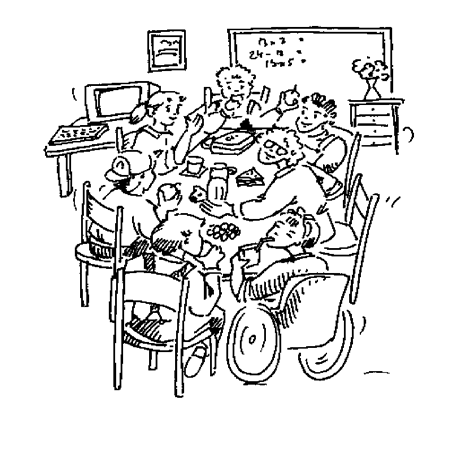
- Volunteers and professionals who work with children:
Children spend more time outside their family than ever before. Their
interests and activities bring them into contact with people who can
play a role in supporting healthy choices. The example of someone children
look up to - coach, teacher, camp leader, group leader - can have a
powerful effect on children through the example they set. Your unspoken
example, such as munching on fruit for a snack, can strongly support
what you tell children about healthy eating and healthy living.
- Media messages: Children absorb an enormous
amount of information from the media.Advertisements, TV shows, movies,
celebrities and sports stars can have a big influence on children and
on their food choices.Children are often not aware of how much influence
TV and other media have on their food choices. Parents, however, report
that they base their decisions about purchasing many foods on their
children's preferences, and parents cite TV as an influence on these
preferences.
- Other children: Peer pressure influences
children of all ages and is particularly strong in the early teen years.
Although pre-teen children identify strongly with their family, they
also want to be like the peers whom they admire. Acceptance in information
from the media. A peer group can depend on eating, liking and doing
the same things as the other children in the group.
Activity
To help children understand what influences their
food choices:
- Start a discussion using one of the following questions: What is your
favourite snack? Why? Which of the foods your parents buy regularly
are your favourite? Why?
- On a flipchart or a board, list the reasons why these foods are their
favourite.
- Discuss with the children what influences their eating habits: e.g.
taste of foods, family, ads, friends.
"I like raspberries because they're juicy and they
have lots of good taste." (Winnipeg child)

Children Have Influence, Too
Children have a strong influence on the foods that are purchased and
eaten in their home. Children tell their parents what they like - and
don't like - and few parents make decisions about the foods they buy and
serve without considering their children's preferences. In your work with
children, you can help them to understand the factors that influence their
preferences and to use their own influence positively.

Activity
To help children realize that they have influence:
- Start a discussion with the children using the following questions:
Which foods do your parents buy because they know you like them? What
do your parents make for supper that they know you enjoy?
- Make five columns on a flipchart or a board, one for each food group
in Canada's Food Guide to Healthy Eating and one for"Other Foods".
- List the foods mentioned in the appropriate column.
- Encourage children to name foods they enjoy eating from each of the
four food groups.
- Through discussion, help children understand that their attitudes
influence the people around them and that they can be leaders when it
comes to eating well.
"As parents we have the greatest influence - we
purchase and prepare the food, and we have control over what they eat."
(Toronto parent)


Setting Healthy Patterns for Life
There's more to healthy eating than food! Eating well, being active
and feeling good about yourself are three aspects of healthy living that
are interdependent.
For example, when children are active, they are more likely to feel good
about themselves and to recognize when they are hungry and when they are
full. This allows them to eat enough to meet their nutritional needs and
have the energy they need to be active. Children who are hungry or who
don't eat well are less likely to have enough energy to be active and
to get involved in activities that will help them to feel good about themselves.
Promote eating well in the context of being active and feeling good about
yourself. This will guide children on the path to healthy living.
Being Active
Most children enjoy physical activity, especially activities that they
can do with their friends and which give them a feeling of accomplishment
- building snowman, skating or swimming. Many children are also involved
in organized sports and other activities, like hockey, soccer, gymnastics,
basketball and dance. In fact, balancing their activities with their food
needs is very important. This is discussed in the section Different
Children Have Different Energy Needs.
However, there's a tendency for school-age children to spend more and
more of their time in less active pursuits, like watching TV or playing
computer/video games. Children may need both encouragement and the opportunity
to get up and moving.
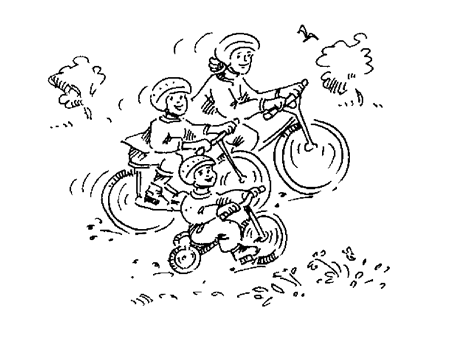
"They're both healthy for you - if you eat right you'll
stay healthy, and if you exercise you'll stay healthy."(Winnipeg child)
"If you eat healthy, you'll stay slim, but if you get
heavy even if you eat healthy foods, that's just the way your body is."(Winnipeg
child)

Practical Suggestions
To help children enjoy physical activity:
- Add active time to your sessions with children. Get them to stand
up, have a good stretch, bring shoulders to ear lobes, jump on the spot,
shake all over... Build in time to play outside.
- Make physical activity fun. Being active doesn't always have to involve
winners and losers. It can be fun for all children, not just the ones
who are "good" at sports or physical activity.
- Plan group outings, like hikes and rallies. Even cammunity chores
such as raking leaves or picking up litter can be fun when done in a
group.
- Make it easier for children in your communtiy to be physically active.
Work with parents, communtiy leaders and schools to build in active
time. For example:
- Lobby for daily physical education to be part of every child's
school program.
- Encourage schools to offer lunch-time and after-school physical
activities, sports team's and clubs.
- Work to improve local playgrounds. Ask for enough space and solid,
safe equipment for children of various ages.
Feeling Good about Yourself
Children come in many different shapes and sizes. Our different shapes
are among the things that make each of us unique, and they are determined
largely by genetics. Being comfortable with your body is an important
step in developing a good sense of self and getting on with living.
During their school years, children begin to move out into a wider world.
They begin to compare themselves to others - their friends, other children
from school, characters in movies and TV shows, sports heroes or people
they admire. Children also do not gain height and weight at the same time.
For many children, it is normal to gain weight before a growth spurt.
When this happens, children can feel chubby. It takes a strong, healthy
sense of self-esteem for children to feel good about themselves in these
circumstances.
Practical Suggestions
To help children feel good about themselves:
- Accept children as they are, no matter their weight, size or shape.
Focus on children's abilities, not their appearance.
- Listen when children talk to you. Listen to their concerns about their
changing bodes end their feelings. Take them seriously and help then
keep things in perspective. Learn about the physical changes that came
with puberty so you can explain them in easy to understand terms.
- Promote healthy eating but resist coaxing heavy children to diet or
convincing small children to eat more. Encourage children to decide
for themselves how much to eat and help them make healthy choices.
- Feel good about yourself. Children are more likely to feel good about
themselves when the adults they look up to have a positive view of themselves
"I'm scared about making them too self-conscious, so we
don't talk about how their body looks."(Halifax parent)

Children Who Are Overweight
We live in a culture that can be cruel to children who are heavier than
what is considered to be "normal." Some children try to lose weight by
dieting because they fear becoming fat. This can be the start of a lifetime
of restrictive eating in a fruitless effort to reach unrealistic goals
of thinness and body shape.
However, some children are overweight to the point where it may be a
health concern. There is evidence that overweight is increasing among
children and is linked to a lack of physical activity. Qualified health
professionals, such as a physician or dietitian, are in the best position
to assess if a child is overweight.
Children who are overweight need support to enable them to make healthy
food choices, participate in physical activities and accept themselves
as worthwhile people because of their abilities no matter what they weigh.
Because body size is determined by genetics, many heavy children will
never be "thin." However, they can be healthy, active people who feel
good about themselves and their lives.

What Is Healthy Eating for Children?
During their school years, children are becoming more responsible for
making choices about what they eat and more assertive about making their
own decisions. Many children begin preparing their own breakfasts, lunches
and snacks.
During this time, parents and adults who work with children struggle
to strike a balance between helping children make good choices and respecting
their ability to make their own decisions. Children have built-in cues
- like hunger, feeling full, thirst and taste - to help them decide what
and when to eat. Other tools - like Canada's Food Guide to Healthy Eating and food labels - are available to help guide them in setting
healthy eating patterns. You can use all of these tools to help children
develop decision-making skills for healthy eating.
Enjoying a Variety of Foods
Canada's Food Guide to Healthy Eating encourages eating and enjoying
a "variety of foods from each group every day." This helps children meet
their nutrient needs. As well, ensuring a variety of choices helps avoid
the boredom that can come from eating the same foods day in and day out.
Variety also means trying foods from other cultures which can help children
learn about their friends and the world around them. And, in the rush
to do all of the things that six- to twelve year-olds do, variety means
that eating on the run can be as interesting and nutritious as a sit-down
meal!
Building a Pattern of Healthy Eating
Canada's Food Guide to Healthy Eating uses a rainbow to show that
just as diff e rent colours make a rainbow, different food groups are
the basis of a healthy eating pattern. The Food Guide gives direction
on which foods to emphasize and how to expand the range of foods we eat.
In the Food Guide, it is the overall pattern of foods eaten over time
that is important to health. The key to healthy eating lies in finding
a balance among the many different kinds of food people eat. Although
we may need more of some foods and less of others, each kind of food can
be part of healthy eating.
Children eat mainly from the four food groups to meet their nutrient
needs. However, Other Foods - foods that are not part of any of the four
food groups - can also add energy and some nourishment.
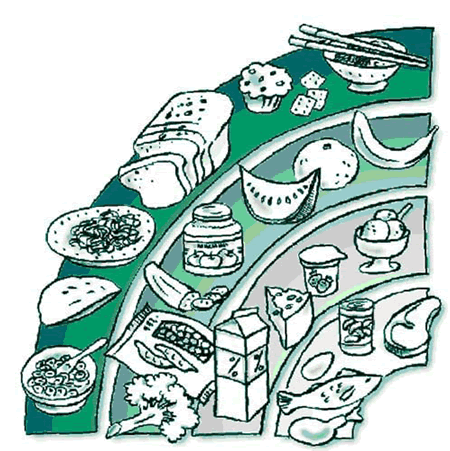
Grain Products Choose whole grain and enriched
products more often.
Vegetables & Fruit Choose dark green
and orange vegetables and orange fruit more often.
Milk Products Choose lower-fat milk products
more often.
Meat & Alternatives Choose leaner meats,
poultry and fish, as well as dried peas, beans and lentils more often.
Activity
To help children enjoy a wider ranqe of foods:
- Ask children if they would like to eat the same thing all the time.Then,
Iead a discussion on how choosing a variety of foods can make eating
fun.
Have younqer children draw pictures of two
or more different breakfasts, lunches or dinners that they like to eat.
Help them complete their meals using suggestions from the Food Guide.
Get older children to talk about different
ways they can combine foods to make salads, pizzas and sandwiches.
- Ask children to think about foods coming from other countries, which
bring variety to our menus. Here are a few examples: pita bread, French
"baguette", souvlaki, chili, tofu.
- Organize a tasting party with foods and dishes enjoyed by various
ethnic and cultural groups. Each child can bring a food or a dish from
home.
"The food Guide tells you which food is more important
so you can eat a lot of it."(Toronto child)
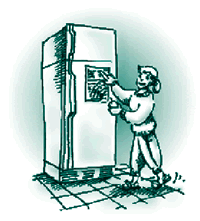
OTHER FOODS
What are Other Foods? Other Foods include a wide range of items, such
as butter, margarine, oil, jam, snack foods like potato chips and pretzels,
water, soft drinks, fruit-flavoured drinks, seasonings and condiments
like ketchup. They can be part of a healthy eating pattern, but they shouldn't
displace foods from the four food groups. Help children learn to:
- experiment with the natural flavours of foods. For example, taste
food before adding salt, salty seasonings, condiments, salad dressings,
butter or margarine, and then use only what you need.
- choose lower-fat and lower-salt snack foods more often.
- use caffeine in moderation. It is found in colas, chocolate and foods
that contain cocoa.
DON'T FORGET WATER
Encourage children to drink water to quench their thirst. Children need
more water during hot weather and when they're playing hard. Active children
usually drink a lot. However, listening to thirst is not always enough.
Ensure that children have easy access to water when they are physically
active and the weather is hot. Having their own water bottle can help
increase how much water children drink.
Most beverages (for example, milk, juices, soft drinks) and many foods
(for example, fruit) are good sources of water. However, offering plain
water quenches thirst, is inexpensive, helps prevent tooth decay and doesn't
ruin children's appetite for food. Unless they are involved in intense
training for sports competition, children don't need special drinks to
replenish fluids.
DO CHILDREN HAVE SPECIAL VITAMIN OR MINERAL NEEDS?
Not usually. If children are healthy, growing well and eating a variety
of foods, they are not likely to need a vitamin-mineral supplement.
For example, there is an increase in calcium needs prior to puberty.
This is why the Food Guide recommends that children increase the number
of servings of Milk Products to 3-4 per day. A supplement is unnecessary.
In special cases, some children may need supplements if:
- their eating patterns do not include enough milk or milk products;
- they do not eat animal products (meat, milk or milk products, or eggs);
- food choices are limited by food intolerance, allergies, personal
dislikes, cultural preferences or religious beliefs; and
- the drinking water is not fluoridated.
If children's preferences are the issue, you can start by looking for
alternative foods that can help meet the child's nutrient needs. For example,
look for other foods within the same food group. Or to better suit children's
preferences, you can help them find different ways to eat foods. For example,
children who don't like cooked vegetables might not mind raw carrot s
, vegetable soup or stews.
If you are concerned that a child is not getting the nutrients needed
to grow and be healthy, suggest to the parents that they consult a professional
- a registered dietitian or physician - who can assess the child's food
intake and find the best way to help the child meet his or her needs.
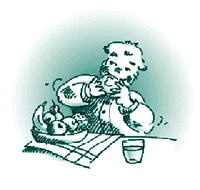
I think my eating is healthy. but some of my friends eat
too much junk food and candy gum and chips - and then they don't eat their
lunch. (Toronto child)
Activity
To help children make healthy food choices by usinq the
information on food labels:
- Ask children to bring empty cereal boxes from home.
- ExpIain that the Food Guide recommends that we choose whole and enriched
grain products more often.
- Ask the chiIdren how they can tell which cereals are whole grain and
which are enriched. By looking at the name? The list of ingredients?
The nutrition information panel? The clams on the box? The picture?
Hints to identify whole grains and enriched cereals:
- Look at the ingredient list. Whole grains, like whole wheat, should
be near the top of the list.
- You will know that the cereal is enriched if the ingredient list
includes these nutrients: iron (often listed as ferrous sulfate),
niacin, riboflavin and thiamin.
- Using Food Labels to Choose Foods for Healthy Eating is also a valuable
teaching resource.

Rethinking "Good" Food, "Bad" Food
When asked about healthy eating, children tend to classify foods as "good"
or "bad." This good/bad split will not help children develop a positive
approach toward eating.
The Food Guide avoids labelling individual foods as good or bad. It is
the overall pattern of eating that is important to health. As well, many
educators use the terms "everyday" foods and "sometimes" foods as a more
positive alternative.
Energy for Growth, Development and Activity
Meeting children's energy needs for growth, development and activity
is a priority for healthy eating. Both carbohydrate and fat are import
a n t sources of energy (Calories) in foods.
Eating More Starchy Foods
The Food Guide recommends that we try to get more of our food energy
from complex carbohydrates - that's starchy food! That's why more servings
of Grain Products and Vegetables and Fruit are recommended and why legumes
are promoted as a meat alternative. Foods high in complex carbohydrates
include grain-based foods, vegetables and legumes. Lots of the foods that
children like fall into these categories. Oatmeal, rice, break - fast
cereals, bread and noodles are all favourite grain choices. Potatoes,
peas, corn and sweet potato head up the list in the vegetables category.
And most children like a legume whether they or their parents know it
yet or not! Baked beans, chili and pea soup are good places to start talking
about legume choices.
Fat For Children
The Food Guide recommends that we choose lower-fat foods more often.
This applies to children as well as to adults. Learning to enjoy lower-fat
milk products, leaner meats, fish and poultry, and foods prepared with
less fat helps set a pattern of healthy, life-long eating. For more examples
of lower and higher-fat foods, see Food Guide
Facts: Background for Educators and Communicators in the section More
Materials on Children and Healthy Eating. Be sure, however, that
children understand that some fat is necessary for good health. "Lowerfat
foods more often" does not mean NO fat. Higher-fat nutritious foods are
a concentrated energy source and can help children meet their energy needs,
especially during those times when their needs are higher. When children's
energy needs are higher, you can expect them to eat more of everything,
including higher-fat foods.
"If you don't try different foods you won't know if they're
good."(Hull child)
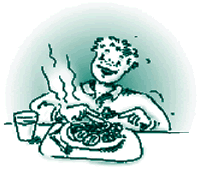
Different Children Have Different Energy Needs
Children's active lives and their growing bodies have a huge impact on
their energy needs. However, meeting increasing and varying energy needs
of children is not as challenging as it may seem. Here are the basics:
- All children are different, lead different lives
and have different energy needs. The amount of food and the number
of servings children need will depend on their gender, their body size,
how physically active they are and how fast they are growing.
Although children's energy needs tend to increase through to puberty,
this increase is not steady. Children grow according to their own patterns.
They often have growth spurts during which they get skinnier even though
their appetite is increasing. Or, they will put on weight just before
an increase in height. As a general rule, if children eat according
to their appetites and choose foods from the four food groups, over
time they will get the nourishment they need.
Girls tend to mature and stop gro wing earlier than boys. For this reason,
girls' energy needs will tend to level off and even decrease at an age
when boys' appetites will continue to increase sharply.
- When children are healthy and active, their appetite
is the best guide to how much they should eat. During growth
spurts and periods of increased activity, children need more energy,
feel hungrier and eat more. For example, at camp where they are involved
in a lot of outdoor activities, children's appetite may increase drastically
and then go back to normal a couple of days after the camp.
This means making food available to children when they need it! If they
are famished after school, a hearty snack or an early dinner are in
order. This can help children make it through after-school activities
with energy and enthusiasm.
On the other hand, when children are bored or not feeling well, some
will have difficulty judging whether they are hungry or full. The best
approach here is not to try to control their food intake, but to address
the boredom or illness.
- The Food Guide promotes a flexible eating pattern
that meets children's needs. That's why the Food Guide suggests
a range of servings from each food group. This allows children to increase
or decrease how much they eat based on their needs at any given time.
For example, girls between seven and nine years of age have about the
same energy needs as adult women. They will tend to choose the lower
to middle number of servings. Girls 10 to 12 and boys 7 to 12 need more
energy and are more likely to eat more servings.
It may seem as if the number of servings of Grain Products or Vegetables
and Fruit is very high. Keep in mind, however, that the Food Guide refers
to serving sizes that are not large. Children
often have more than one serving at a time. For example, a cup of spaghetti,
a bagel or a hamburger bun each count as two
servings of Grain Products. A 250-ml juice box counts as two
servings of Vegetables and Fruit.
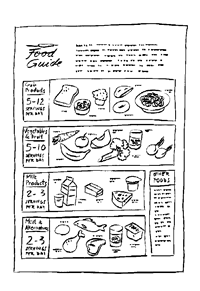
Snacking and Dental Health
Snacking is an important part of healthy eating for growing children.
However, children can be at risk for tooth decay if they tend to snack
often and don't spend much time brushing their teeth. Here are some suggestions
to promote dental health:
- Encourage nutritious snacks chosen from the food groups.
- Vary the snack menu to decrease children's exposure to snacks which
are more apt to cause cavities.
- Discourage day-long nibbling and prolonged sipping of beverages containing
sugars. Even nutritious snacks can cause tooth decay if children eat
too often throughout the day. Up to three snacks a day is a healthy
snacking pattern.
- It is always best to brush teeth after eating. When brushing is not
possible, chewing sugarless gum or, at least, carefully rinsing the
mouth with water can help decrease the risk of tooth decay.

Snack ideas
Children enjoy tasty, nutritious snacks they can reach for easily:
- cut-up, raw vegetables with crackers and tasty yogourt dip.
- sliced or whole fruit with cheese, yogourt or milk.
- variety of breads with cheese or peanut butter.
- ready-to-eat or hot cereals with pieces of fruit.
- plain popcorn with grated cheese and juice.
- homemade breads or muffins and milk.
Activity
To interest children in meal planning and preparation:
- Write the names of each food group on a flipchart or a board in separate
columns. Ask children to name foods they like to eat for breakfast and
list them in the appropriate food group.
- Using these food choices, ask them to make breakfast menus, including
foods from at least 3 of the 4 food groups. If necessary, help children
find other foods they like to eat for breakfast.
Other suggestions
- Ask the children if they sometimes leave home without having breakfast
because they "don't have time" to eat. Ask them to list foods
that could be eaten on the way to school.
- Discuss with children the importance of breakfast for them: for example,
to stay healthy, to be in a good mood, to feel good, to be alert.
- As a group, plan a meal for a party an outing or a sporting event:
- Base the menu on the Food Guide.
- Write the grocery list and go to the supermarket.
- Prepare the meal together and enjoy the outcome.
TEACH CHILDREN FOOD SAFETY
- Wash hands before handling food.
- Wash and sanitize utensils and working surfaces after handling raw
foods and before handling cooked or ready-to-serve foods.
- Avoid germ growth. Don't let protein- rich foods (for instance, meat,
poultry, milk products, and fish or egg dishes) stand at room temperature.
One way to keep sandwiches cool until lunch time is to pack them next
to a frozen drink or an ice pack.

Making Healthy Eating Easier
Children need healthy choices to be easy, particularly when they are
learning to set patterns for healthy living. Parents, schools and communities
need to work with children to create the supportive environments that
will make it easier for children to make healthy choices.
A Note about Allergies
Children and adults alike need to be more aware and sensitive to food
allergies. This means always asking about food allergies before sharing
food.
The number of lifethreatening reactions to food allergies is increasing.
These can happen anywhere at home, in school or recreational facilities,
at camp and on field trips. Make sure your organization has a policy for
handling these allergies and that you are familiar with the measures it
includes.
A good resource is Anaphylaxis: A Handbook for School Boards.
For information on obtaining a copy, see More Materials on Children and
Healthy Eating.
Regardless of which context you find yourself in with children, a supportive
environment for healthy eating needs to include:
- consistency between messages and actions.
Healthy Eating messages can be strongly reinforced through the way foods
are used in the children's environments, (i.e., school lunches, classroom
snacks and parties, sporting events and fundraising activities).
- guidance and support which allows children to
think for themselves. Children between six and twelve years of
age still need reasonable guidelines for what, when and where they eat.
They also need to develop skills to make decisions about food, plan
meals and prepare foods in an appealing manner. The balance between
"licence" and "guidance" should shift as children gain experience and
abilities.
- positive role models. Being comfortable
with the way you and other people look, having a positive attitude toward
healthy eating and healthy living are important influences on children
you spend time with.
- pleasant meal and snack times. Eating
is a social activity and most children enjoy eating with others more
than eating alone. Be sure to allow enough time and provide a comfortable
setting where children can eat without distractions or disruptions.
Where distractions are inevitable, like school lunch or an outdoor lunch
situation, allow children more time to finish eating.
- access to a variety of nutritious foods.
Advocate for the availability of affordable and appealing foods from
each of the four food groups of the Food Guide in vending machines,
canteens and cafeterias.


More Materials on Children and Healthy Eating
This publication and the materials listed below are available, free,
from local or provincial health departments or from:
Publications, Health Canada
Ottawa ON K1A 0K9
Tel: (613) 954-5995
Fax: (613) 941-5366
Canada's food guide to healthy eating
A colourful, illustrated 8" 1/2 x 11-inch sheet suitable for hanging
on refrigerators. Illustrates the four food groups and shows the number
of servings recommended from each. Helps to set healthy eating patterns
by assisting with daily food selections.
Using the food guide
An illustrated 11-page booklet that explains the Food Guide concepts
more fully, provides additional information and offers ways to use the
Food Guide to support healthy eating.
Using food labels to choose foods for healthy eating
An illustrated 8-page booklet that explains what nutrition labels mean
and how to read them. It suggests ways to use the information that labels
contain to shop for healthy foods.
Food Guide Facts: Background for Educators and Communicators
A series of 11 fact sheets that provide background information for nutrition
p rofessionals, health educators, home economists and others who pro m
o t e healthy eating. Explains the Food Guide in detail and covers ways
to use the Food Guide to meet individual needs.
Canada's Food Guide to Healthy Eating: Focus on Preschoolers
A 16-page booklet for educators and communicators that discusses healthy
eating for preschool children two to five years of age.
Vitaliy Leader's Kit*
Background information as well as tips and tools which can help adults
modify their own approach to healthy living and healthy weight.
Food for Thought: An Exploratory Study on Children and Healthy Eating*
An overview report of the findings of a study that looked at Canadian
children's understanding of healthy eating concepts and their views on
their own eating behaviour and the factors that influence their food choices.
Promoting Healthy Eating to Schoolaged Children and Youth: Examples
of Innovative Strategies Across Canada, 1998 *
Offers brief, one-page summaries of innovative programs in a variety
of settings and with many different goals and approaches. Includes addresses
and contacts for obtaining more information about each program.
* Only available from Health Canada
Canada's Food Guide to Healthy Eating Poster
A large (24" high by 36" wide), colour poster version of the
Food Guide.
Cost: $4.95 plus shipping and handling. Discount available for bulk
orders.
Order the Food Guide poster described above from:
Canada Communication
Group Publishing
Ottawa ON K1A 0S9
Phone: (819) 956-4802
Fax: (819) 994-1498
ANAPHYLAXIS: A HANDBOOK FOR SCHOOL BOARDS
A 58-page handbook that provides the background information required
to begin developing policies for life-threatening food allergies.
Order the above resource from:
Canadian School Boards
Association 130 Slater Street,
Suite 350, Ottawa, ON K1P 6E2
Phone: (613) 235-3724
Fax: (613) 238-8434
Internet:  www.cdnsba.org www.cdnsba.org
MEDIA AWARENESS NETWORK
A World Wide Web site dedicated to media education and media issues affecting
children and youth. It presents health-related teaching units and resources
in the "Health Issues" section of the site.
Check the Network site at:
 http://www.schoolnet.ca http://www.schoolnet.ca
To Find Out More
To find out more about healthy eating and available resources, contact
nutritionists and dietitians through local or community health centres,
public health units or provincial departments of health.

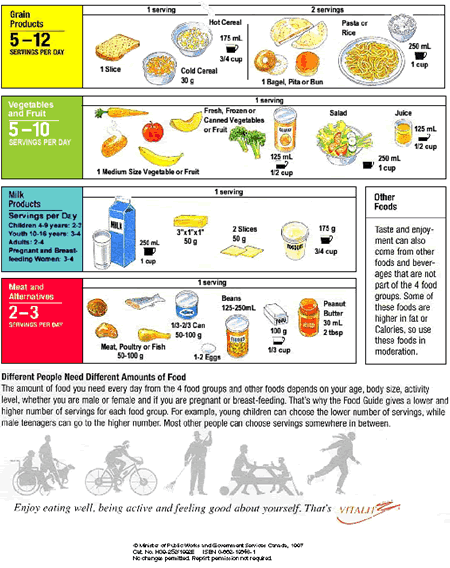
|
